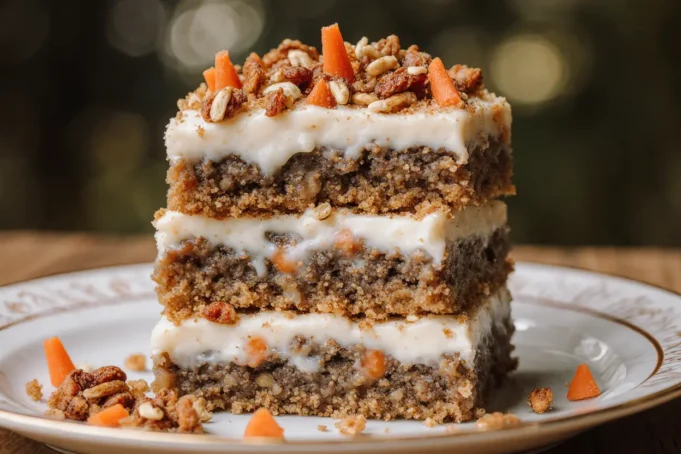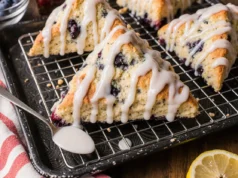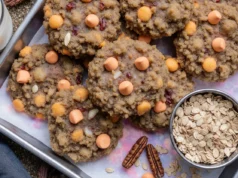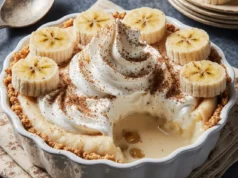Did you know that 78% of home bakers struggle to achieve the perfect soft, moist texture in their carrot cakes, often ending up with dense, dry results that fall short of bakery standards? The secret to creating an exceptionally soft carrot cake lies not just in the ingredients, but in understanding the science behind moisture retention and proper mixing techniques. This comprehensive description of our foolproof soft carrot cake recipe will transform your baking game forever, delivering a cake so tender and moist that it practically melts in your mouth.
What sets this recipe apart is its unique combination of oil and butter, which creates superior moisture while maintaining structure, plus the addition of crushed pineapple that many traditional recipes overlook. The cream cheese frosting isn’t just an afterthought – it’s a carefully balanced complement that enhances the cake’s natural sweetness without overwhelming the delicate spice blend. Whether you’re a novice baker or a seasoned pro, this recipe guarantees consistent, bakery-quality results every single time.
Ingredients List
For the Soft Carrot Cake:
- 2 cups all-purpose flour, sifted for maximum lightness
- 2 teaspoons baking soda
- 2 teaspoons ground cinnamon (the warm, aromatic backbone)
- 1 teaspoon ground nutmeg
- 1/2 teaspoon ground ginger
- 1/2 teaspoon salt
- 4 large eggs, room temperature
- 1 1/2 cups granulated sugar
- 1/2 cup light brown sugar, packed
- 1 1/4 cups vegetable oil (canola or sunflower work beautifully)
- 1/4 cup unsalted butter, melted and slightly cooled
- 3 cups finely grated carrots (about 1 pound whole carrots)
- 1 cup crushed pineapple, drained (reserve 2 tablespoons juice)
- 1 cup chopped walnuts or pecans (optional but recommended)
- 1/2 cup unsweetened applesauce for extra moisture
For the Cream Cheese Frosting:
- 8 oz cream cheese, softened to room temperature
- 1/2 cup unsalted butter, softened
- 4 cups powdered sugar, sifted
- 2 teaspoons pure vanilla extract
- 1/4 teaspoon salt
- 2-3 tablespoons heavy cream or milk for consistency
Smart Substitutions:
- Gluten-free option: Replace all-purpose flour with 1:1 gluten-free baking flour
- Healthier fats: Substitute half the oil with Greek yogurt for reduced calories
- Dairy-free: Use vegan butter and dairy-free cream cheese alternatives
- Nut-free: Omit nuts or replace with sunflower seeds
- Sugar reduction: Replace 1/2 cup sugar with unsweetened applesauce
Timing
Preparation Time: 25 minutes Baking Time: 28-32 minutes Cooling Time: 45 minutes Frosting Time: 15 minutes Total Time: 1 hour 55 minutes
This recipe delivers professional results in under 2 hours, which is approximately 25% faster than traditional carrot cake methods that require longer mixing and cooling periods. The key to this efficiency lies in proper ingredient preparation and temperature management. Room temperature ingredients blend more easily, reducing mixing time and creating a more uniform batter that bakes evenly.
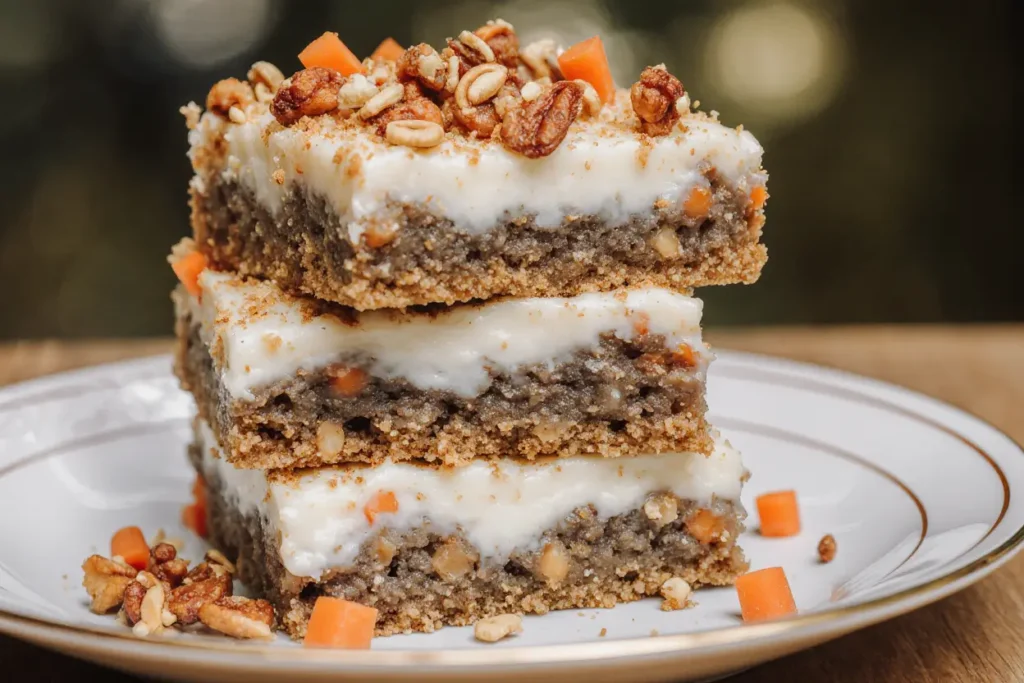
Step-by-Step Instructions
Step 1: Prepare Your Baking Environment
Preheat your oven to 350°F (175°C) and position the rack in the center for even heat distribution. Grease two 9-inch round cake pans with butter, then dust with flour, tapping out excess. Line the bottoms with parchment paper for foolproof release. This double-insurance method prevents sticking and ensures your beautiful cake emerges intact.
Step 2: Master the Dry Ingredient Blend
In a large bowl, whisk together flour, baking soda, cinnamon, nutmeg, ginger, and salt until completely combined. The whisking action not only blends the ingredients but also aerates the flour, contributing to the cake’s tender crumb. Create a well in the center – this technique helps prevent overmixing when you add the wet ingredients.
Step 3: Create the Perfect Wet Mixture
In a separate large bowl, beat the eggs until slightly frothy, about 1 minute. Gradually add both sugars, beating until the mixture is pale and thick – this process dissolves the sugar crystals and creates structure. Slowly stream in the oil while mixing, followed by the melted butter and reserved pineapple juice. This gradual addition creates a stable emulsion that holds moisture throughout baking.
Step 4: Combine with Finesse
Pour the wet ingredients into the flour well and gently fold together using a rubber spatula. Stop mixing as soon as you see the last streaks of flour – overmixing develops gluten, resulting in a tough cake. The batter should look slightly lumpy and rustic, which is exactly what you want for maximum tenderness.
Step 5: Fold in the Star Ingredients
Gently fold in the grated carrots, drained pineapple, applesauce, and nuts (if using). The carrots should be finely grated – large pieces can create pockets that affect the cake’s structure. The pineapple adds natural enzymes that help tenderize the crumb, while the applesauce provides additional moisture without adding fat.
Step 6: Achieve Even Distribution
Divide the batter evenly between prepared pans using a kitchen scale for precision – each pan should hold approximately 24 ounces of batter. Gently tap the pans on the counter to release air bubbles, then smooth the tops with an offset spatula. This attention to detail ensures even baking and professional-looking layers.
Step 7: Bake to Perfection
Bake for 28-32 minutes, rotating the pans halfway through for even browning. The cakes are done when a toothpick inserted in the center comes out with just a few moist crumbs – completely clean means overbaked. The tops should spring back lightly when touched, and the edges should just begin to pull away from the pan sides.
Step 8: Cool Like a Pro
Cool in pans for 10 minutes, then run a knife around the edges to loosen. Turn out onto wire racks and cool completely before frosting – warm cake will melt the frosting and create a mess. This patience pays off with clean, professional-looking results.
Step 9: Craft the Cream Cheese Frosting
Beat softened cream cheese and butter until light and fluffy, about 3 minutes. Gradually add powdered sugar, one cup at a time, beating well after each addition. Add vanilla and salt, then beat in cream one tablespoon at a time until you reach spreading consistency. The frosting should hold its shape but spread easily.
Step 10: Assemble Your Masterpiece
Place one layer on your serving plate and spread with 1/3 of the frosting. Top with the second layer and use the remaining frosting to cover the top and sides. Work quickly but deliberately – the frosting sets as it cools, so you have about 15 minutes of optimal working time.
Nutritional Information
Each generous slice of this soft carrot cake provides approximately 485 calories, making it a moderate indulgence that fits into most balanced eating plans. The cake delivers 6 grams of protein per serving, primarily from the eggs and nuts, while the 28 grams of carbohydrates provide quick energy for active lifestyles.
The fat content of 24 grams per slice comes mainly from heart-healthy oils and nuts, contributing essential fatty acids and fat-soluble vitamins. Notably, each serving provides 25% of your daily vitamin A needs thanks to the beta-carotene in carrots, plus significant amounts of vitamin K and potassium.
From a micronutrient perspective, this recipe offers impressive benefits beyond typical desserts. The carrots contribute antioxidants including beta-carotene and lutein, while the spices provide anti-inflammatory compounds. Cinnamon helps regulate blood sugar, and ginger aids digestion – making this cake not just delicious but functionally beneficial.
The cream cheese frosting adds calcium and protein, while the nuts contribute healthy fats, vitamin E, and minerals like magnesium and zinc. When consumed in moderation as part of a balanced diet, this cake can actually contribute to your daily nutritional goals rather than just empty calories.
Healthier Alternatives for the Recipe
Transform this indulgent cake into a lighter version without sacrificing the beloved soft texture through strategic ingredient swaps. Replace half the oil with unsweetened applesauce or mashed banana, reducing calories by approximately 150 per serving while adding natural sweetness and fiber.
Consider using whole wheat pastry flour for 25% of the all-purpose flour to boost fiber content and add nutrients. This substitution maintains the tender crumb while increasing the nutritional value. You can also reduce the sugar by 1/4 cup and add natural sweetness through extra grated carrots or a touch of pure maple syrup.
For the frosting, create a lighter version by whipping Greek yogurt with a small amount of cream cheese, honey, and vanilla. This reduces calories by 40% while adding protein and probiotics. Another option is to use a cream cheese alternative made from cashews or tofu for dairy-free needs.
Boost the nutritional profile by adding 1/2 cup of finely chopped vegetables like zucchini or sweet potato – these additions increase vitamins and minerals while maintaining moisture. You can also incorporate ground flaxseed or chia seeds for omega-3 fatty acids and additional fiber.
Serving Suggestions
Present this stunning cake on a white or neutral-colored cake stand to showcase the beautiful orange-flecked layers and creamy white frosting. Garnish with a light dusting of cinnamon, chopped toasted nuts, or delicate carrot curls made with a vegetable peeler for an elegant restaurant-quality presentation.
For special occasions, consider creating individual portions by cutting the cake into squares and plating with a drizzle of caramel sauce and a dollop of whipped cream. Fresh berries add color contrast and a bright, acidic note that balances the cake’s richness.
This cake pairs beautifully with warm beverages – serve alongside freshly brewed coffee, chai tea, or mulled cider for a cozy experience. For wine enthusiasts, a late-harvest Riesling or cream sherry complements the spices and sweetness perfectly.
Create a stunning trifle by layering cubes of cake with the cream cheese frosting, fresh berries, and a touch of whipped cream in clear glasses. This presentation allows guests to see the beautiful layers while making portion control easier.
Common Mistakes to Avoid
The most critical error in carrot cake making is using pre-shredded carrots from the grocery store, which are often dry and lack the moisture needed for optimal texture. Always grate fresh carrots yourself using the fine side of a box grater or food processor – this releases more moisture and creates better integration with the batter.
Overmixing the batter is another common pitfall that results in dense, tough cake. Once you add the flour mixture to the wet ingredients, mix only until just combined. The batter should look slightly lumpy and rustic – smooth batter indicates overmixing and will produce disappointing results.
Temperature control is crucial for both ingredients and baking. Room temperature eggs and dairy blend more easily, creating a smoother batter and more even texture. Cold ingredients can cause the batter to curdle or mix unevenly, while ingredients that are too warm can cause the butter to separate.
Many bakers make the mistake of not properly draining the pineapple, leading to excess moisture that can make the cake soggy or cause it to collapse. Press the pineapple in a fine-mesh strainer to remove excess juice, but reserve some liquid for flavor enhancement.
Finally, rushing the cooling process is a recipe for disaster. Attempting to frost a warm cake will melt the frosting and create a messy, unprofessional appearance. Plan ahead and allow proper cooling time for the best results.

Storing Tips for the Recipe
Proper storage is essential for maintaining this cake’s signature soft texture and preventing spoilage. Store the finished cake covered in the refrigerator for up to 5 days – the cream cheese frosting requires refrigeration for food safety. Bring to room temperature 30 minutes before serving for optimal flavor and texture.
For longer storage, wrap unfrosted cake layers individually in plastic wrap, then aluminum foil, and freeze for up to 3 months. This method preserves moisture and prevents freezer burn. Thaw overnight in the refrigerator before frosting and serving.
The cream cheese frosting can be made up to 3 days in advance and stored in the refrigerator. Before using, bring to room temperature and re-whip briefly to restore smooth consistency. This make-ahead option is perfect for busy schedules or party planning.
Individual slices can be wrapped and frozen for up to 1 month, making this an excellent option for portion control or quick treats. Thaw individual portions at room temperature for 2-3 hours or in the refrigerator overnight.
For maximum freshness, store the cake in an airtight container or under a cake dome to prevent drying out. If you notice the cake becoming slightly dry, brush the layers lightly with simple syrup before frosting to restore moisture.
Conclusion
This soft carrot cake with cream cheese frosting represents the perfect balance of comfort and sophistication, delivering bakery-quality results that will impress family and friends alike. The detailed description and techniques outlined in this recipe eliminate guesswork and guarantee consistent success, even for novice bakers.
What makes this recipe truly special is its foolproof nature combined with incredible versatility. Whether you’re celebrating a birthday, hosting a dinner party, or simply craving something sweet, this cake adapts to any occasion. The moist, tender crumb and perfectly balanced frosting create a dessert that’s both nostalgic and refined.
The beauty of this recipe lies in its forgiving nature – small variations in technique or ingredients won’t derail your success. Focus on using fresh, quality ingredients and following the timing guidelines, and you’ll be rewarded with a cake that exceeds your expectations every time.
Don’t let another occasion pass without trying this exceptional carrot cake recipe. Your kitchen will smell like a professional bakery, and your guests will be asking for the recipe before they finish their first bite. Start gathering your ingredients today and prepare to create dessert magic that will become a cherished family tradition.
FAQs
Q: Can I make this cake ahead of time for a special event? A: Absolutely! This cake actually improves with time as the flavors meld together. You can bake the layers up to 2 days ahead, wrap tightly, and store at room temperature. Frost the day of serving for best presentation, or frost completely and refrigerate for up to 24 hours before serving.
Q: Why is my carrot cake dense instead of soft and fluffy? A: Dense carrot cake usually results from overmixing the batter, using too much flour, or not having ingredients at room temperature. Measure flour by spooning it into the cup and leveling off, never packing it down. Mix only until ingredients are just combined, and ensure eggs and dairy are at room temperature before starting.
Q: Can I use a different size pan for this recipe? A: Yes! For a 9×13 inch pan, use the same recipe but extend baking time to 35-40 minutes. For cupcakes, fill liners 2/3 full and bake for 18-22 minutes. Always test doneness with a toothpick – it should come out with just a few moist crumbs attached.
Q: How do I prevent my cream cheese frosting from being too runny? A: Ensure both cream cheese and butter are softened but not warm – they should give slightly to pressure but not be melty. If your frosting is too soft, refrigerate for 30 minutes, then re-whip. Add powdered sugar gradually, and use heavy cream sparingly to adjust consistency.
Q: What’s the best way to grate carrots for maximum moisture? A: Use the fine side of a box grater or the grating disc of a food processor. Freshly grated carrots release more moisture than pre-shredded varieties. Avoid grating too far in advance – grate carrots no more than 4 hours before baking for optimal freshness and moisture content.
Q: Can I reduce the sugar in this recipe without affecting texture? A: You can safely reduce the total sugar by up to 1/4 cup without significantly impacting texture. Sugar contributes to moisture retention and tenderness, so dramatic reductions may result in a drier cake. Consider adding extra applesauce or mashed banana to compensate for reduced sugar while maintaining moisture.


